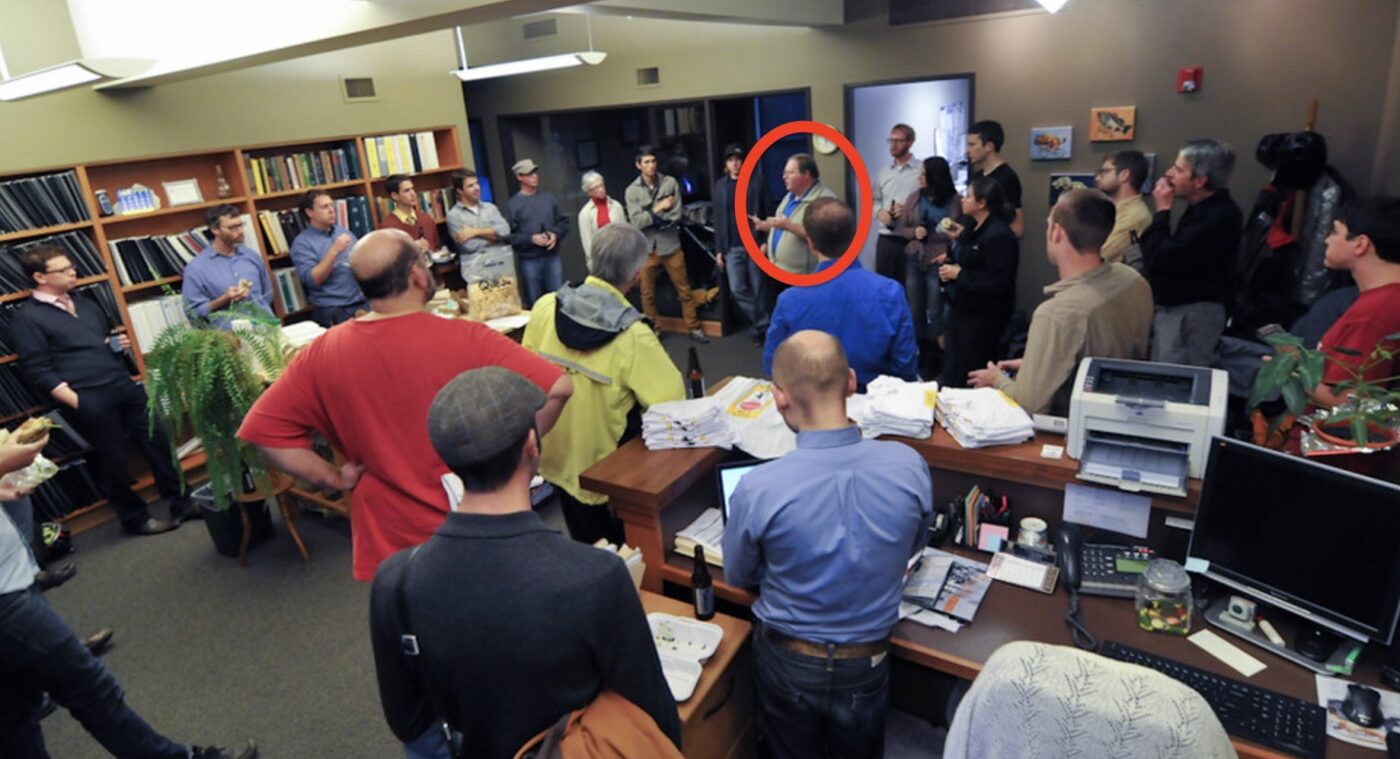Publisher’s note: Four years ago, Portland completed a major recommendation of the Bicycle Master Plan by adopting robust standards for bicycle parking in new construction. Now, amidst concern about housing production, the City is considering rolling back major pieces of it. Chris Smith, a transportation advocate, former planning commissioner, and one of the architects of the current bike parking code, believes the debate around housing production versus bike parking is a false choice.
“Parking is a fertility drug for cars” is a common refrain among advocates who are part of movement sweeping the nation (and already law in Oregon) to eliminate automobile parking minimums. I’m convinced the same is true for cycling.
An adequate amount of convenient bike parking is a fertility drug for cycling, which is why I helped shepherd a package of amendments to Portland’s bike parking code through the Planning and Sustainability Commission in 2019. These amendments increased the amount of required parking for multi-family housing slightly, but mostly made sure that the parking was actually useful and convenient.
Is it hypocritical to support minimums for one type of parking while opposing minimums for another? I don’t believe so, and the reason is simple: driving has many negative externalities (fatal collisions, air pollution, noise, greenhouse gases, congestion, etc…) while cycling has many positive ones (improved air quality, promotion of physical health, more efficient use of road space, much less expensive vehicles, opportunity for personal interactions, etc…). All of our regional and city plans recognize this by calling for less driving (in the form of miles traveled per capita) and more cycling.
The promotion of cycling requires several elements: safe and convenient infrastructure, adequate parking, access to bicycles, as well as encouragement programs. Looking at the two infrastructure requirements — safe infrastructure and parking — they develop on different timelines. We can build a protected bike lane and it gets used tomorrow, but the person using that lane will need to rely on parking at their home that was built some time ago. That’s why it makes sense to require new construction to provide parking for the level of cycling that we expect not today — but 10, 25 or 50 years from now.
Yes that means today we see half-full bike rooms, and I understand why to some folks that looks like wasted money. To me it looks like an investment in a more sustainable future.
Our Housing Emergency: Can we blame bike parking?
We have a serious shortfall of housing production in Portland and City Council’s attention has lately turned to the cost of building new housing with an eye toward adjusting or rolling back things like System Development Charges, our Inclusionary Housing Policy and bike parking.
BAE Urban Economics, a consulting firm retained by the City to study the issue, recently presented an analysis that bike parking accounts for 3-6% of multi-family building costs, and that bike parking was adding $11,000 per dwelling unit.
That range of costs has two bases. The first is the actual cost of construction of the bike room space, which is probably the lower range. The higher number is based on opportunity cost, i.e., the rent that could be earned if the bike room space was put to use as living units. I find these calculations suspect and we have yet to see a detailed report that includes all the assumptions for these numbers. Here’s why I’m skeptical:
- While the report works from the basis of a 1.5 bike parking spaces per unit standard, our code actually allows half of all bike parking to be placed in living units (more on this later), which means the bike room space ratio could be as low as 0.75.
- There is no loss of revenue with in-unit bike parking, a tenant is actively paying rent for the space.
- Bike rooms are often windowless spaces that could never be used as living units.
- The ratio in outer pattern areas of the city is actually 1.1
- Our zoning code exempts bike rooms from the limits on overall building size (FAR – floor area ratio), so bike room space is not necessarily in competition with living units Some architects indicate that other limits like height may put the uses back in competition.
- In the presentation, the consultant refers to bike rooms on the ground floor or basement, but our code allows bike rooms on any floor accessible by elevator. Indeed, there is anecdotal evidence that smaller bike rooms on upper floors are more popular, perhaps because of greater perceived security.
On the whole, in the absence of a lot more detail, the $11,000 number seems very pessimistic to me.
Years to make progress, trashed in an instant?

We spent almost five years creating the 2019 amendments, including a robust commenting session at a BikePortland Wonk Night event in 2013 and a full stakeholder process managed by PBOT, followed by a public input discussion draft in the Planning Bureau, then hearings at Planning Commission and City Council. By contrast, these proposed changes would go directly to Planning Commission in September, then fast-tracked to City Council for adoption.
The unsaid part: auto parking still dominates
I’m told by folks involved in the process that the “prototype” financials used in the analysis include an assumed 0.5 car parking ratio, even though none is required by the City. It may still be required by lenders or the developer may perceive that the market demands it. But since structured auto parking can cost up to $50,000 per space, that means construction costs could include $25,000 per unit, far exceeding the $11,000 unit cost for bike parking.
I have a hard time being too concerned about the impact of bike parking when we appear to be just fine with twice as much in auto parking costs.
Are we worrying about the wrong opportunity costs?
Bikes are an affordability tool. A household that can avoid having a car (or a second car) can save over $10,000 per year in vehicle operating costs. But absent a secure bike parking space, that savings opportunity is lost.
There’s also a public sector opportunity cost. If we don’t hit our bicycle mode share goals, in the future we will need to build more expensive auto infrastructure to accommodate growth in trips that aren’t served by cycling as the more affordable infrastructure option.
What should Council do?
I have two recommendations:
- Convene a workgroup to examine the in-unit bike parking standards. In 2019 we preserved this option in the name of affordability, but added standards to make sure we didn’t get bike hooks above beds and other unusable implementations, as we had previously seen without standards. But we’ve gotten feedback that the 2019 in-unit standards are difficult to design to and also difficult to plan check (a process builders must go through to get a permit). Since they were added at the end of the 2019 process, it would be worthwhile to have stakeholders and code experts look at streamlining these in a way that ensures the usability of the parking created while making them easier to implement.
- If Council can get realistic cost impacts of bike parking and determines that this is truly a barrier to building housing, they could consider a temporary roll-back of the bike parking ratio to no less than 1.0 spaces/unit. Any such rollback should have an explicit sunset date. A future Council should have to take formal action to extend such a reduction. If Council decides to take this step, they should do so clearly understanding that they are sacrificing future bicycle mode share to do it.
What Council should not do is eliminate the standards created in 2019 that make sure bike room parking is actually usable by a range of users with different abilities and for bikes of many different types.
We’ve spent more than a century fertilizing driving with a variety of incentives, including costly minimum parking mandates. We’re slowly unwinding those. But as we do so, it’s still more than appropriate that we put some investment into fertilizing more biking!
— Chris Smith, chris@chrissmith.us




